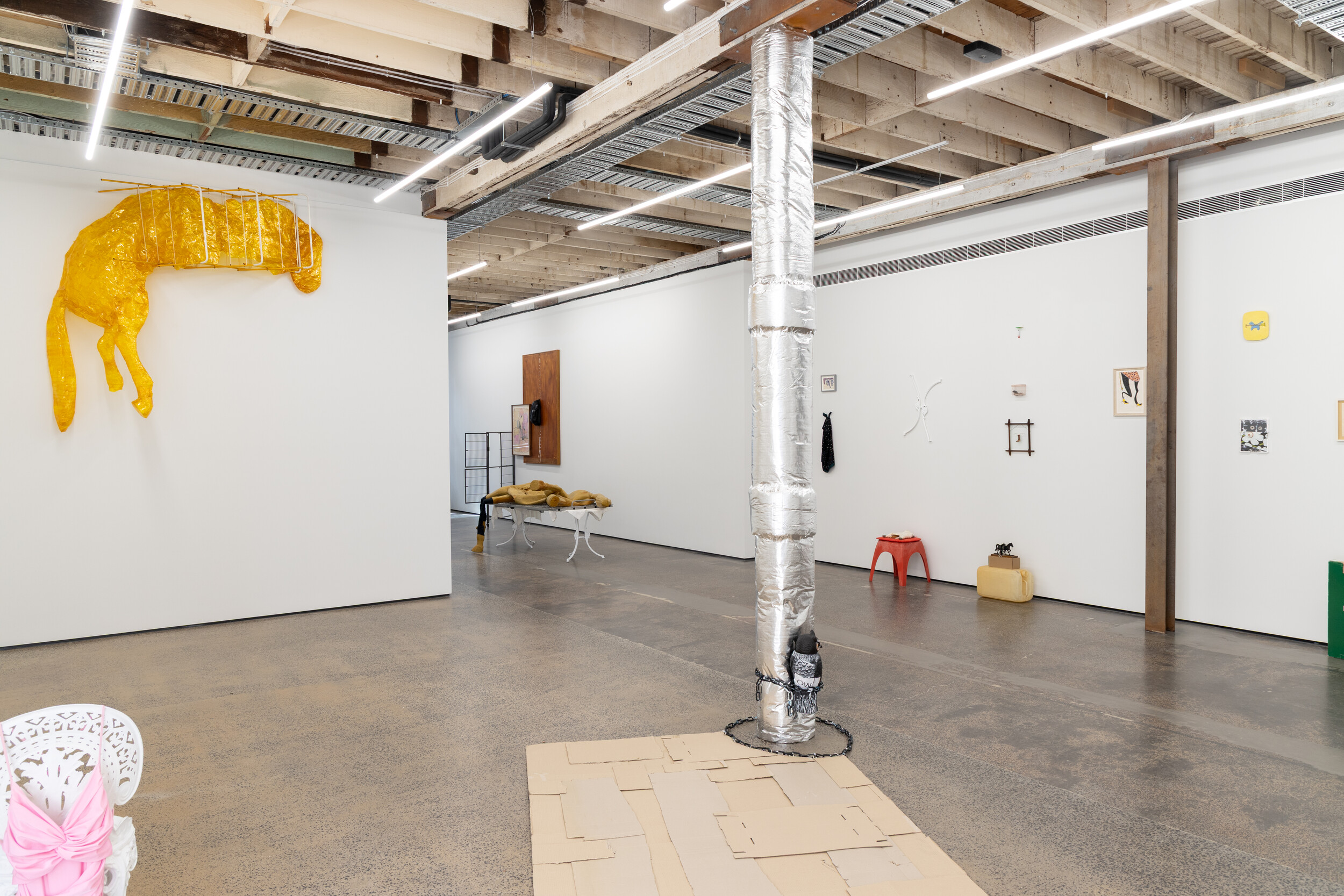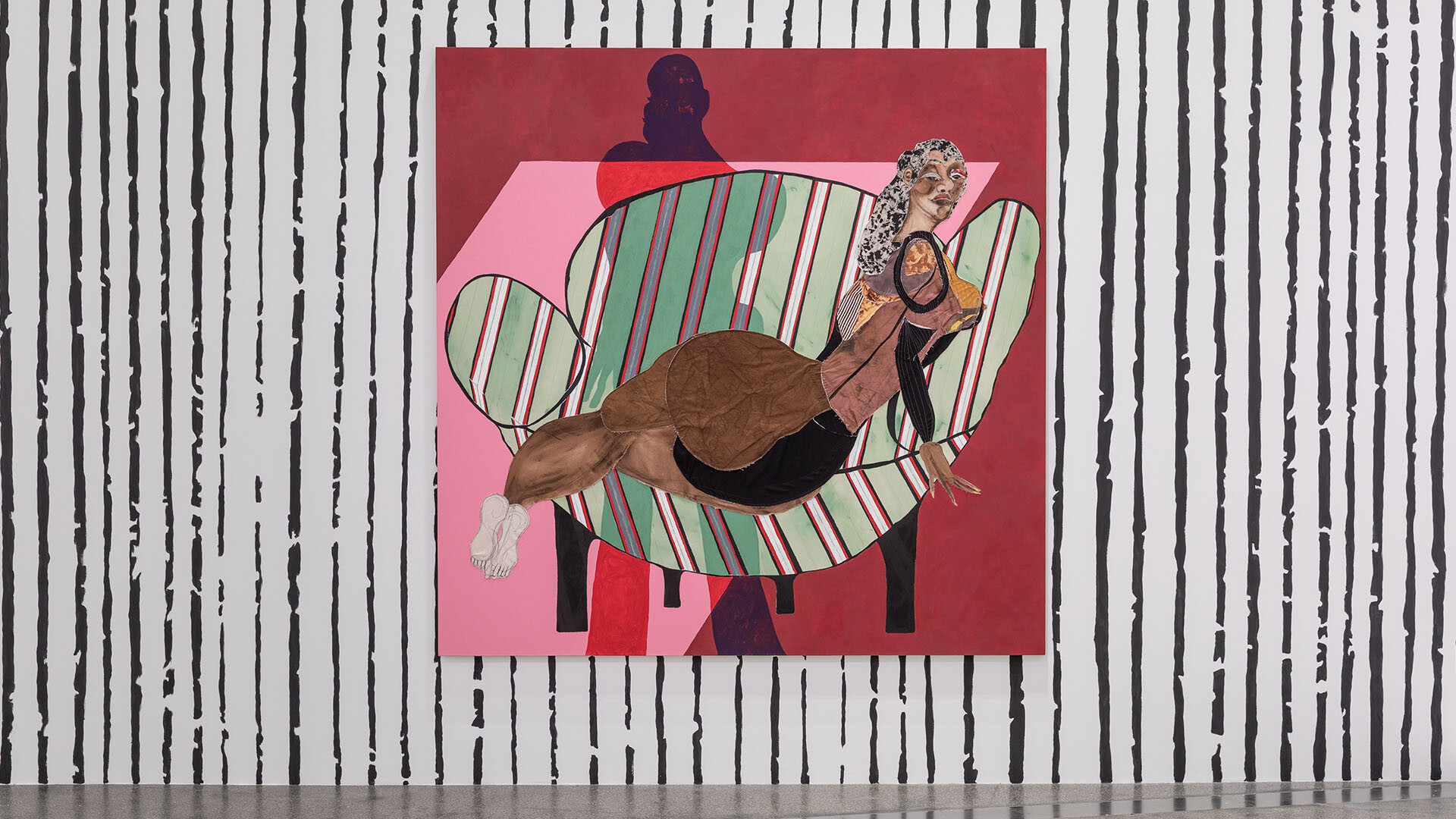KAWS: Companionship in the Age of Loneliness
Paris Lettau
Earlier this week, a group of masked graffiti artists seemed to appropriate the work of Ash Keating—who was commissioned by the National Gallery of Victoria to spray the side of the NGV building in 2013—and descended on the CBD to spray the walls of Melbourne’s iconic Hosier Lane using paint filled fire extinguishers. Their work was a performative protest piece that intended to critique the commercialisation of street culture and graffiti art, and in particular to target the signs and symbols of the Culture Kings streetwear store that now controversially occupies Hosier Lane. The anti-commercialist performance piece was quickly labelled “vandalism” throughout virtually all of the mainstream media and is now being thoroughly investigated by the police.
Around the same time, climate activists who have labelled themselves with the tag #BushfireBrandalism somehow got access to the tram-stop advertising booths near the NGV (posing as JCDecaux contractors) and substituted paid advertisements with climate activism posters. In 2018, JCDecaux supported a clever ad campaign on these boards which showcased Mercedes Benz’s partnership with the NGV—complete with functioning windscreen-wiping advertisements that celebrated the then hugely popular NGV Triennial exhibition. This week, however, JCDecaux has indicated it is aware of the “climate vandalism campaign” that’s going on across its advertising network and is reported to also be considering taking the campaign to the police.
This negative sentiment outside the NGV is set in stark relief with the positive sentiment on the inside, where one of the world’s most talked about artists—Brian Donnelly—is celebrated as the late-90s poster-boy of New Jersey graffiti culture and advertising interventionism (now also alongside Jean-Michel Basquiat and Keith Haring). The exhibition, KAWS: Companionship in the Age of Loneliness, begins with two large scultpures in the forecourt, moves chronologically through twenty-five years of Donnelly’s work, and is divided into three main sections: the actual art exhibit; KAWS Retail (a NGV Design Store Pop-up); and KAWS: Playtime (servicing the NGV Kids program).
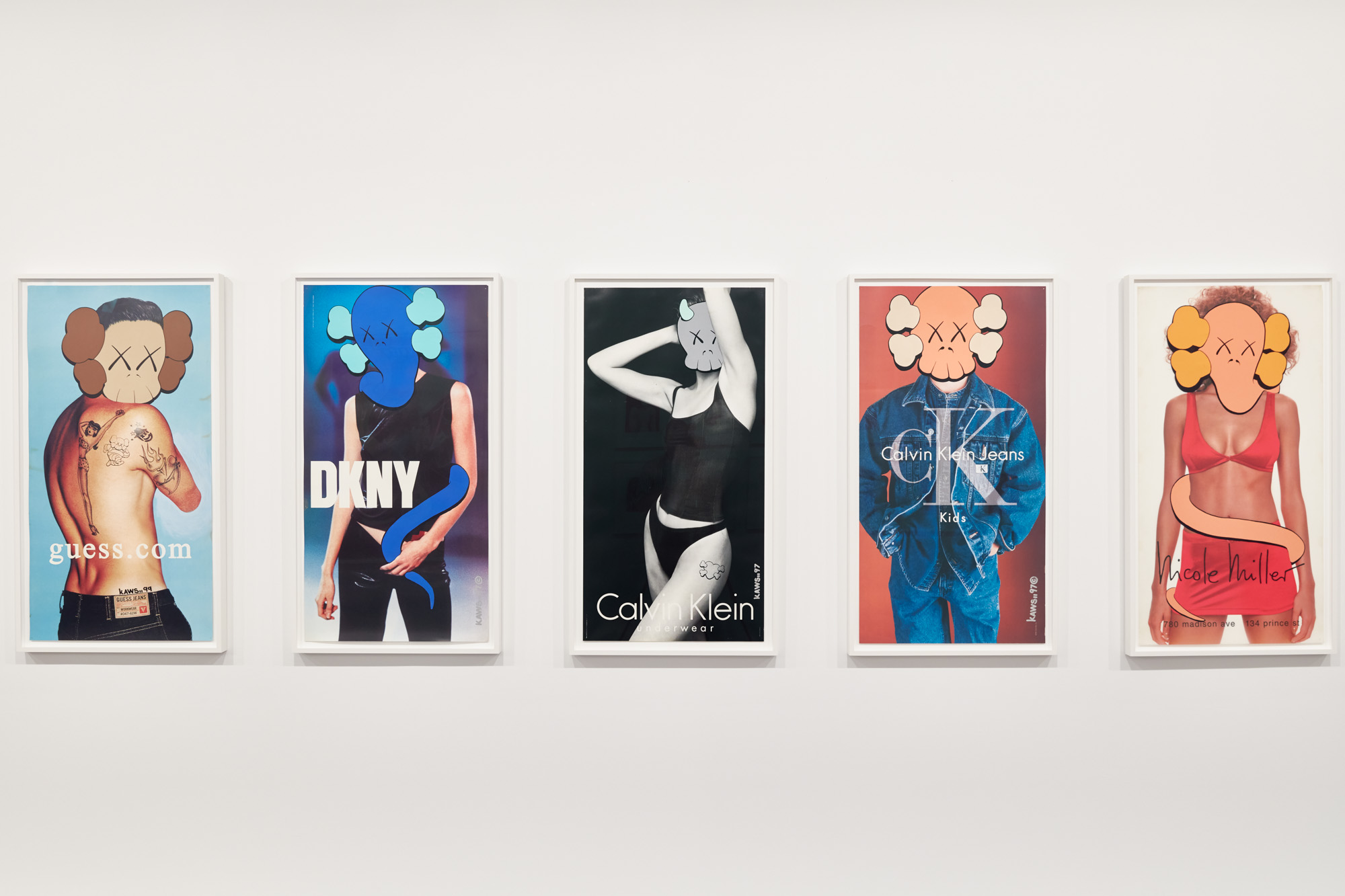
Adorning the walls of the first exhibition space are around a dozen 1990s framed interventions on Guess, DKNY, Calvin Klein and Nicole Miller advertisements and a Keith Haring poster. These interventions were made possible after fellow graffer Twist (Barry McGee) gave Donnelly a master “skeleton” key to the street side advertising boards dotting New Jersey’s phone booths and bus stops (just like the JCDecaux booths targeted by #BushfireBrandalism). These posters largely feature KAWS’s iconic skull-and-crossbones that is a staple (along with the X-eyes) throughout the KAWS universe, and which first appeared in Donnelly’s relatively well-recognised 1996 Marlboro billboard intervention.
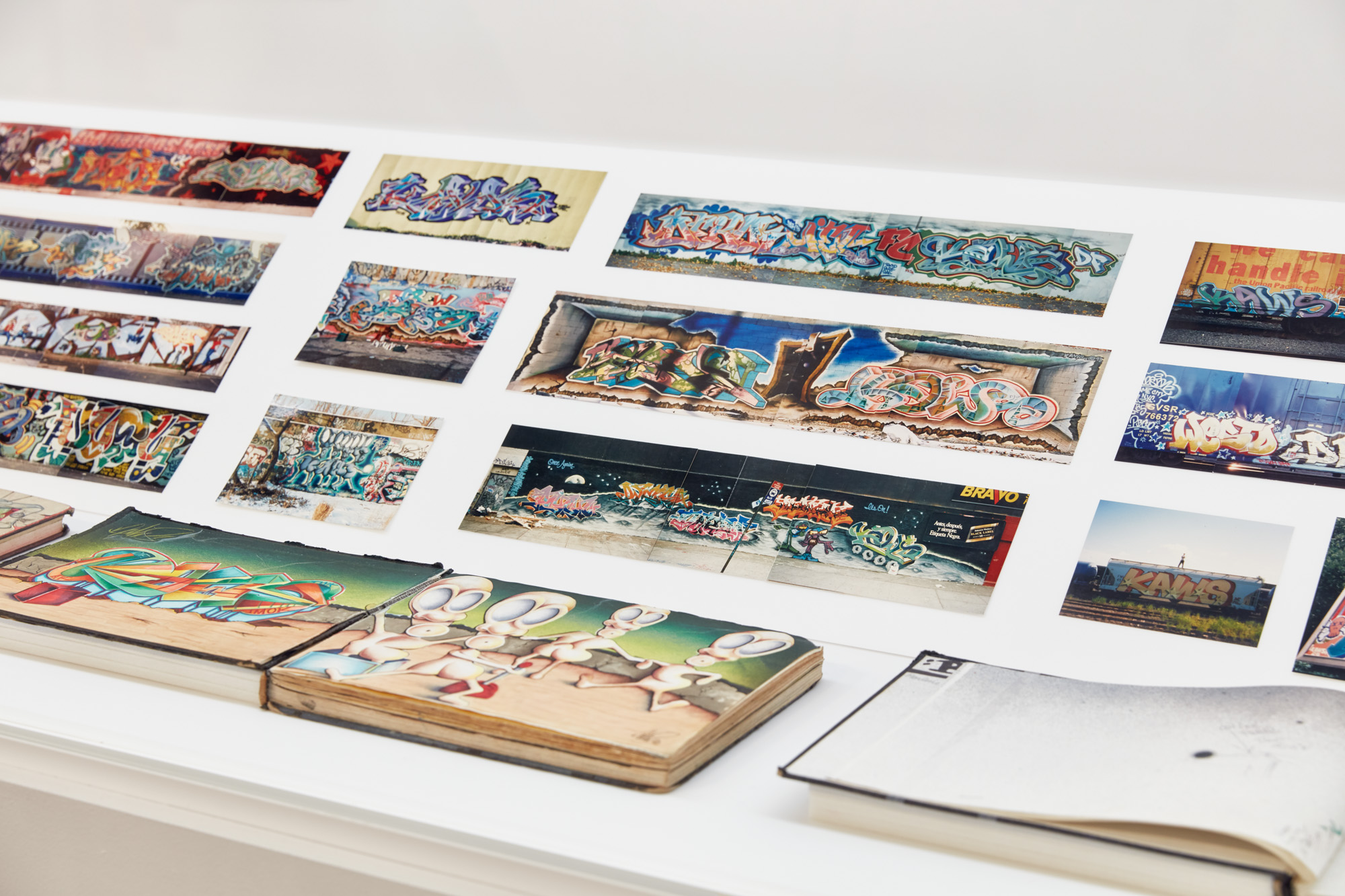
There’s also a large room of KAWS’s TV cartoon-character appropriations, including KAWSBOB and the KIMPSONS works, somewhat jarringly framed by the NGV as belonging to the found object tradition of the Marcel Duchamp ready-made. They are perhaps a kind of ready-made ready-made, in that, like the ready-made, they do away with the original intention of what they appropriate. KAWSBOB 3 (2007) is hung on a long wall with printed semi-trippy red-green wallpaper. The NGV’s rumoured “one-million dollar” wallpaper machine in fact features heavily in the exhibition. Following the KIMPSONS room, one passes a large CHUM (Michelin Man) and BORN TO BEND (Gumby) before entering a floor-to-ceiling room printed in a Jackson Pollock-esque snoopy pattern, complete with a couch made of sewn together cross-eyed Snoopy plush dolls.
The final room is filled with large versions of Donnelly’s famous KAWS toys, including PLUSH, COMPANION, DISSECTED COMPANION, CHUM and BFF. After this room, the main exhibition space ends, and the viewer is directed through to the KAWS Retail and KAWS Playtime space.
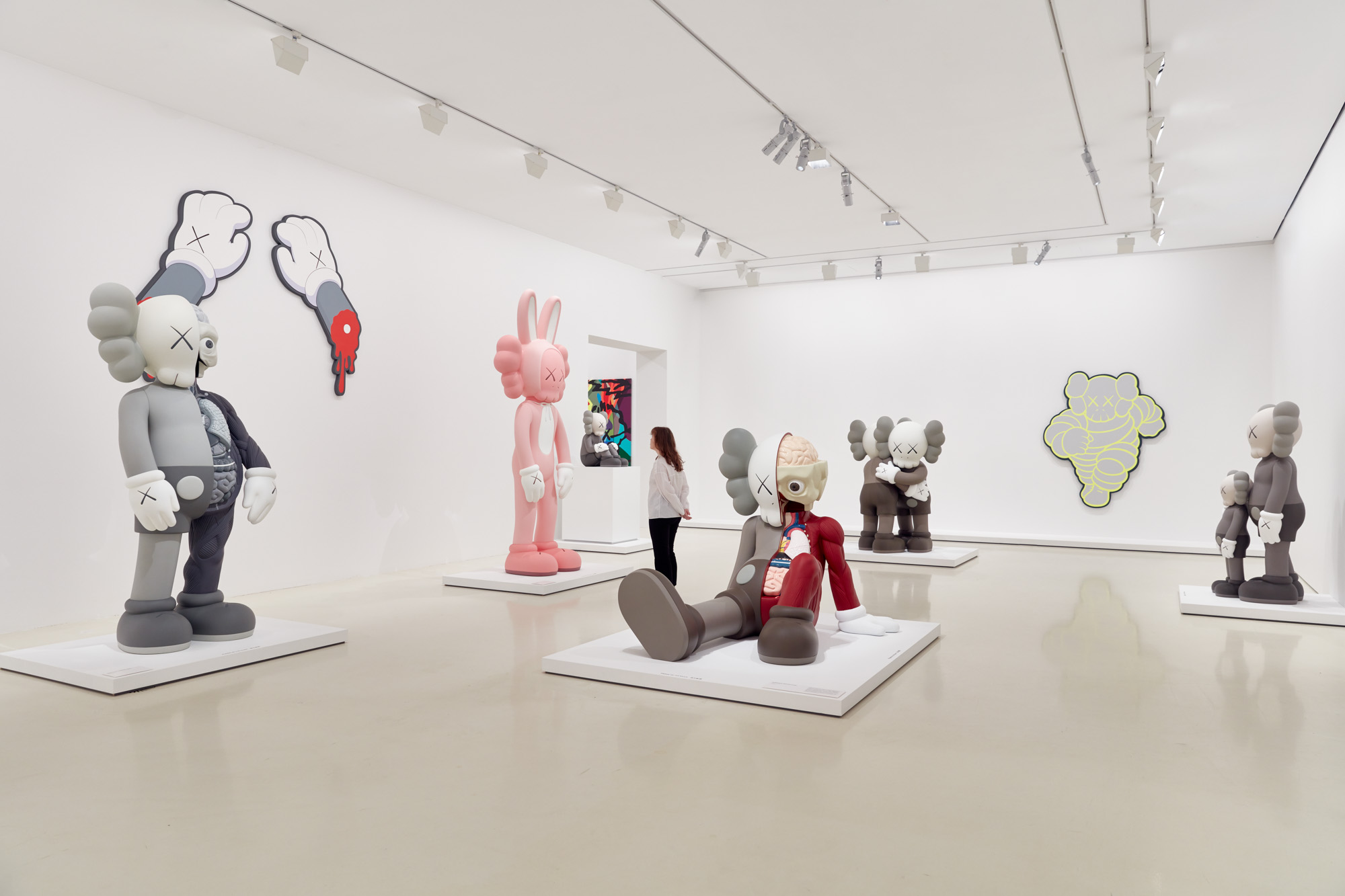
It is KAWS Retail that is the most interesting feature of the exhibition. The staple piece of KAWS Retail is the now sold out KAWS Gone sculpture; however, visitors can also purchase KAWS postcards, greeting cards, pins, tote bags, magnets, notebooks, posters, puzzles and even a KAWS plate set.
Museum directors and gallerists have traditionally snubbed KAWS’s commercialism; the NGV openly embraces it. Few serious critics support his work, but the highly regarded critic Germano Celant (ironically, he coined the term “Arte Povere”) is a notable exception, as is David Platzker (co-editor of Adrian Piper: A Reader) who recently curated KAWS into the exhibition By / Buy me at Susan Inglett Gallery, New York, alongside artists like Jenny Holzer, Claes Oldenburg and Louise Lawler.
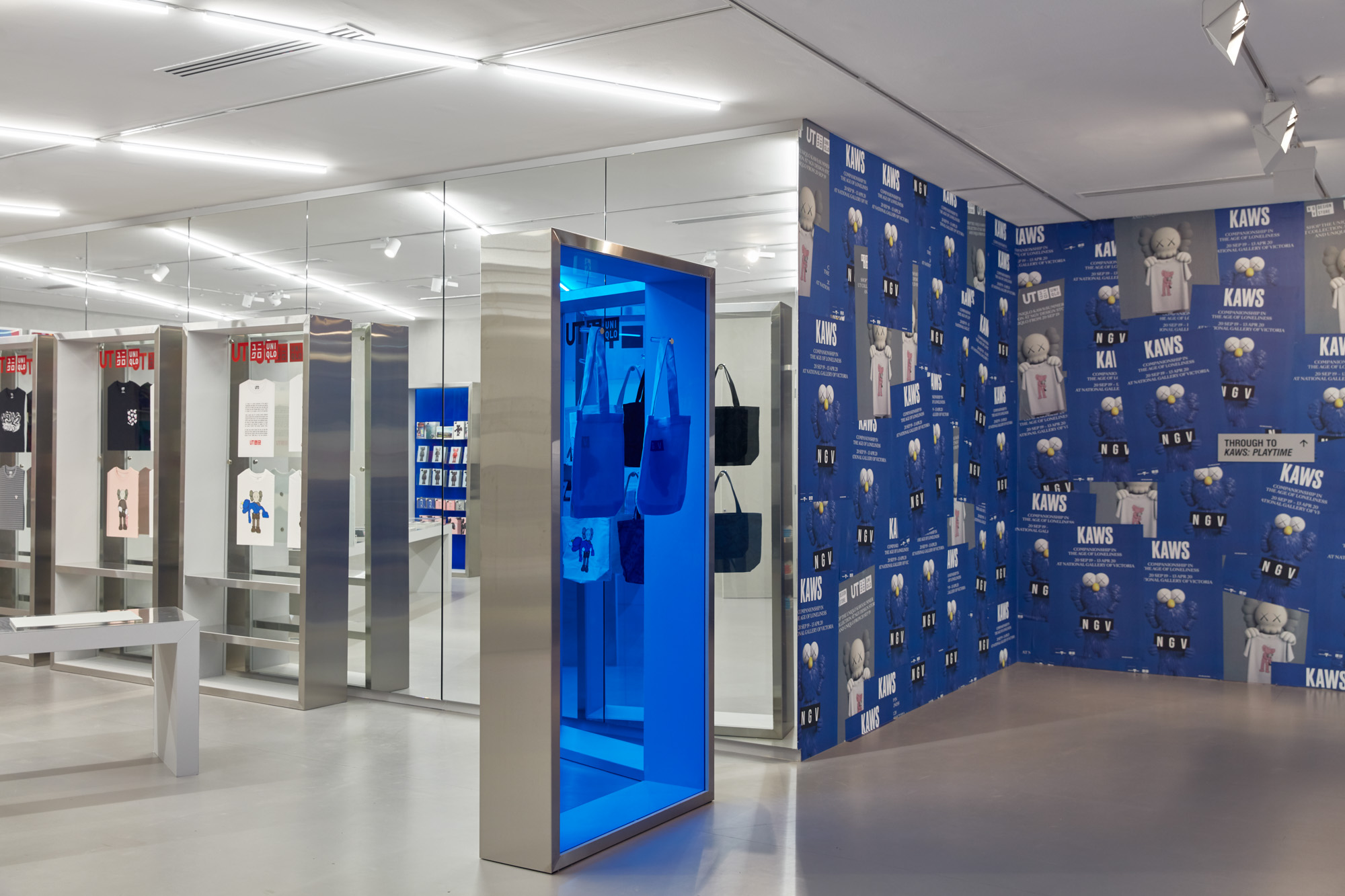
From one perspective, the artworld’s snobbery (which even the reviewers from The Guardian and The Age lambaste) is surprising. KAWS’s artworld commercialism has well-known and critically celebrated precedents in Robert Rauschenberg and Jasper Johns’ Tiffany store in New York, Claes Oldenburg’s The Store (1961) in Manhattan, Keith Haring’s Pop Shop (1986), and even Andy Warhol’s Factory (1962-84).
These artistic precedents questioned the commercialism of art and pushed art towards its event horizon, to the point where it seems like art might end and only commerce remain. A great innovation of KAWS is to reverse the direction: to push commercialisation into the limits of art. Donnelly developed a strong following through early street art and his own Original Fake boutique store, where the KAWS empire effectively began in the wealthy Aoyama (青山) district of Tokyo. Here, Donnelly sold iterations of his approximately 130 different toys that were first developed with Medicom Toys, and subsequently expanded his “direct to consumer” sales model through the internet. But his recent successful move into the mainstream of contemporary art and its auction houses is unprecedented, as is his ability to leverage huge prices across diverse markets (or audiences), from the upper-classes (US$14.7 million last year for The Kaws Album, 2005) to the middle-classes ($985 for a KAWS Gone, 2019, sculpture which first dropped at NGV Retail).
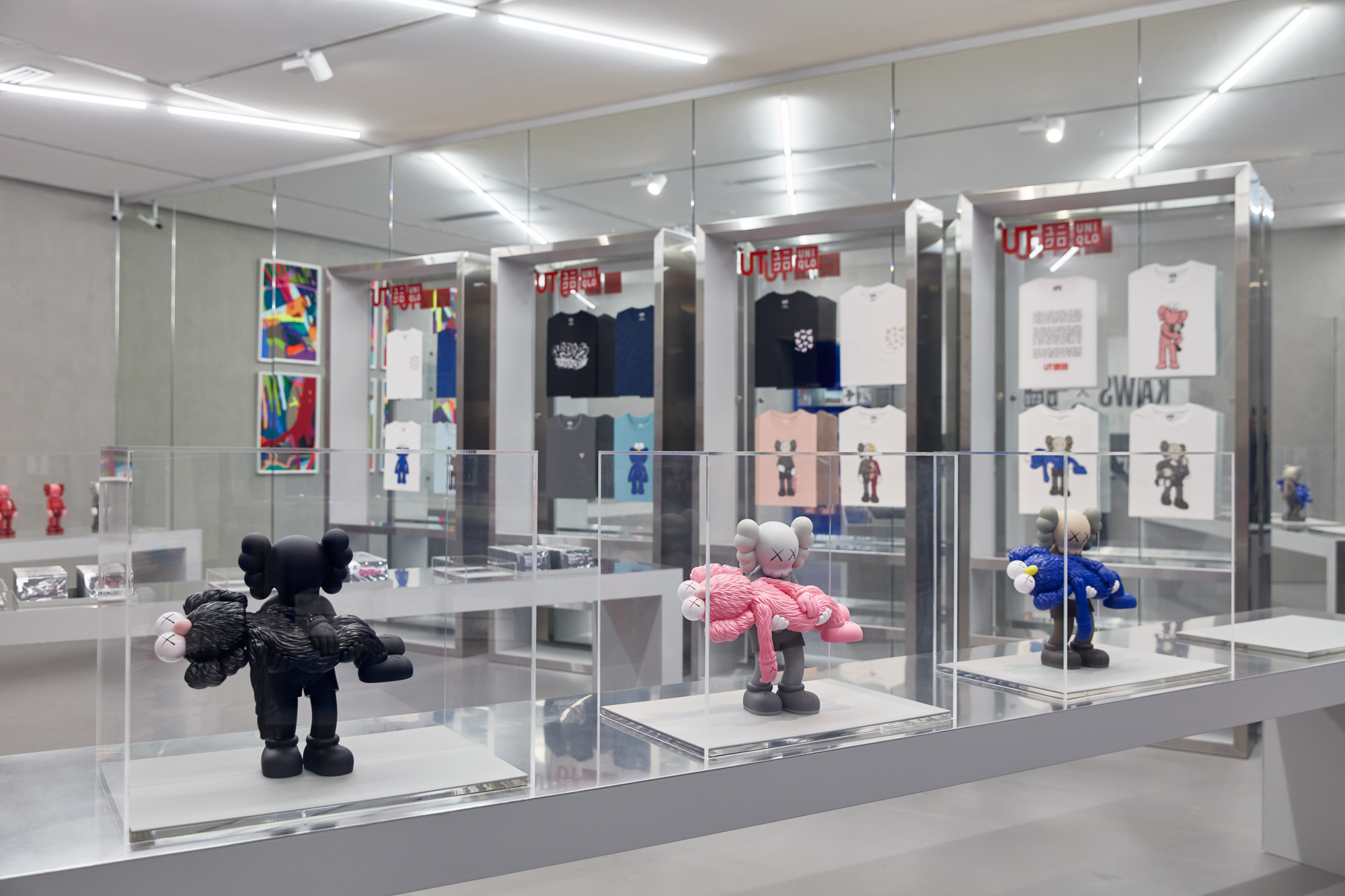
KAWS’s artistic and marketing strategy follows the same hypebeast appropriation model finessed by the streetwear label Supreme (who famously appropriated its logo design from Barbara Kruger’s iconic white-on-red Futura/Helvetica—subsequently resulting in Kruger labelling them “a ridiculous clusterfuck of uncool jokers”).
The unprecedented power of Donnelly’s leverage of “hypebeast” drop culture (which underpins the multi-billion-dollar sneaker re-sale market that Donnelly is also embedded in) makes KAWS an attractive partner for a (globally speaking) relatively minor regional institution like the NGV.
The hype marketing model is a rather straightforward exploitation (already honed to perfection over centuries by the art-market) of the laws of supply and demand: a limited edition or open edition product with a limited initial production run is announced, endorsed by a celebrity icon, and (with the hype having magnified demand) dropped onto the market in a tightly controlled way. It generates huge revenue by mixing streetwear industry with buyers willing to pay for luxury brands. The NGV can now boast that it has joined the long list of KAWS’s elite hype collaborators like Nike, Supreme, Marc Jacobs, Uniqlo, Converse, realmadHECTIC, *A Bathing Ape* (BAPE), Comme des Garçons, Undercover, visvim, Jay-Z, Jermaine Dupris, Pharrell Williams, Kanye West, NIGO and Tomachi Nagas, amongst a host of others.
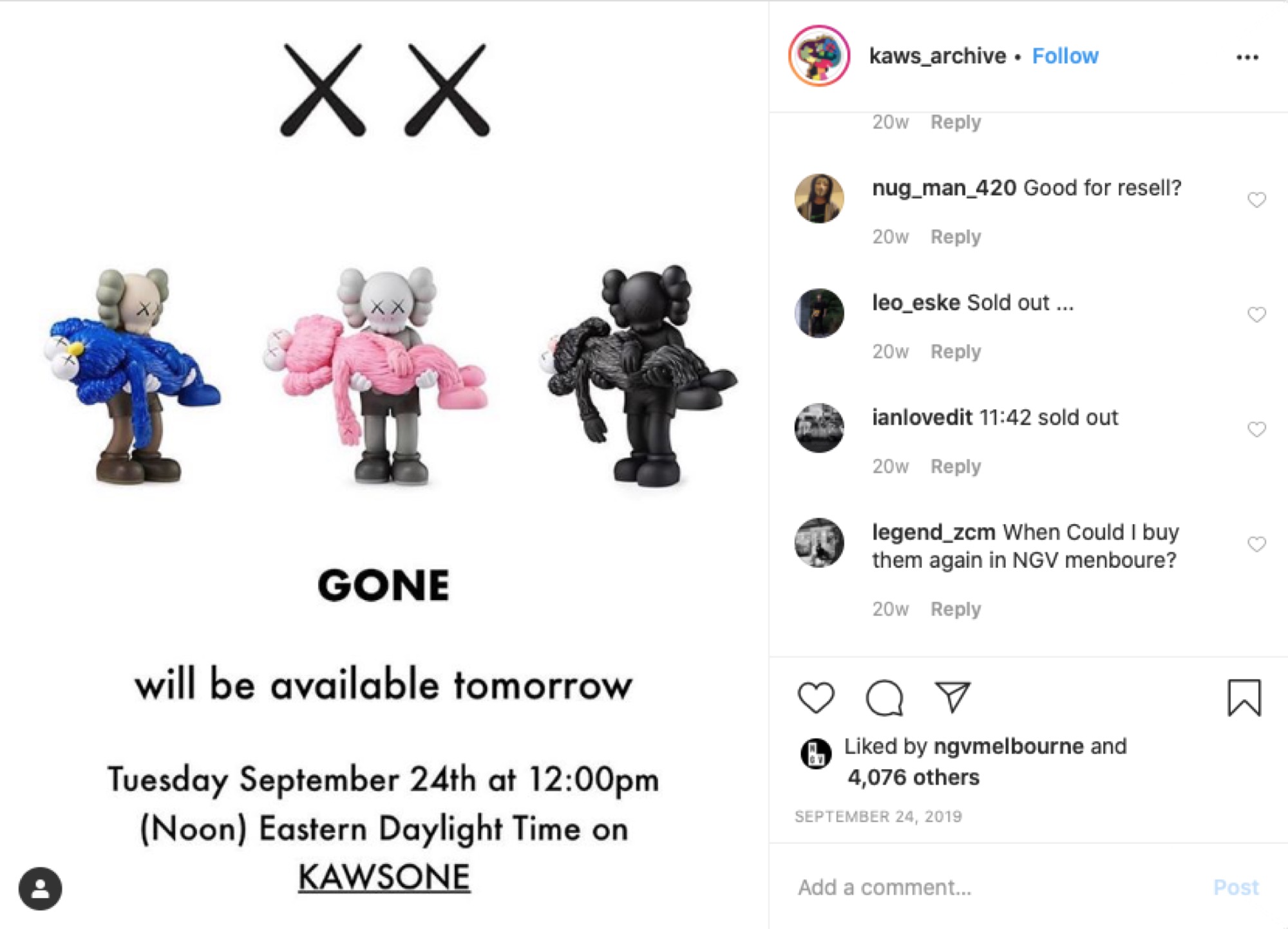
The model was used to drive the initial hype for the KAWS Gone sculpture released at the opening of KAWS: Companionship in the Age of Ownership. Donnelly’s @kaws account made the initial announcement through his Instagram account, however hundreds of hypebeast Instagram accounts like @kaws_archive provided updates to their followers of the drop. When the exhibition opened, there was an extraordinary line of consumer-collectors and re-sale hypebeasts outside the NGV that rivalled depression-era line-ups for bread rations. Fights were reported—reflecting viral scenes from a prior KAWS Uniqlo drop—and some products at KAWS Retail are reported to have sold out within minutes. The NGV even invited local hypebeasts, like YouTuber Monsieur Banana (47K subscribers and 4.1M views) and Hau You Phill (31.7K subscribers and 4.5M views), to the exhibition opening, whose vodcasts show the vloggers eagerly scooping up thousands-of-dollars worth of KAWS merchandise from KAWS Retail.
It’s no surprise that the NGV is also targeting this audience with Keith Haring | Jean-Michel Basquiat: Crossing Lines that now compliments the KAWS exhibition. The opportunities the audience presents explains why this show is also framed through graffiti culture and a “dance club” (even though Basquiat predominantly referenced “high” art figures like Picasso, Matisse and Titian, and most of his musical references are to jazz culture). The exhibition is interesting in that, like Hosier Lane, it has a deeply uncurated feel to it, clearly aimed at enticing the street-culture audience. The commercial linchpin of the KAWS empire is this hypebeast/hypebae culture, and its love of graffiti, street fashion, sneaker culture and limited-edition toys. KAWS’s well-known embeddedness in this culture is further evidenced by the top fifteen most frequent hashtags to appear alongside #kaws (in order of frequency according to an analysis of 600,000 Instagram posts):
#supreme
#offwhite
#hypebeast
#nike
#bape
#adidas
#art
#streetwear
#yeezy
#fashion
#sneakers
#hype
#kanyewest
#jordan
#kawsuniqlo
But the true power of this model is its transformation of the consumer/museum-goer’s perception of what a consumer product is. A significant proportion of buyers of KAWS’s toys see them in the same light as they see sneakers: as a tradeable asset class akin to stocks or bonds.
To give you a sense of how much money this market is capable of absorbing, the global resale sneaker market is projected to reach US $95 billion by 2025—for perspective, the entire Australian education export market is forecast to reach AUD $33 billion by 2025, although these forecasts don’t consider the possible long-term consequences of the Federal Government’s recent China travel ban. Companies like Nike and Adidas are already starting to bypass traditional retail (and retail product pricing) by releasing products directly to consumers via platforms like StockX.
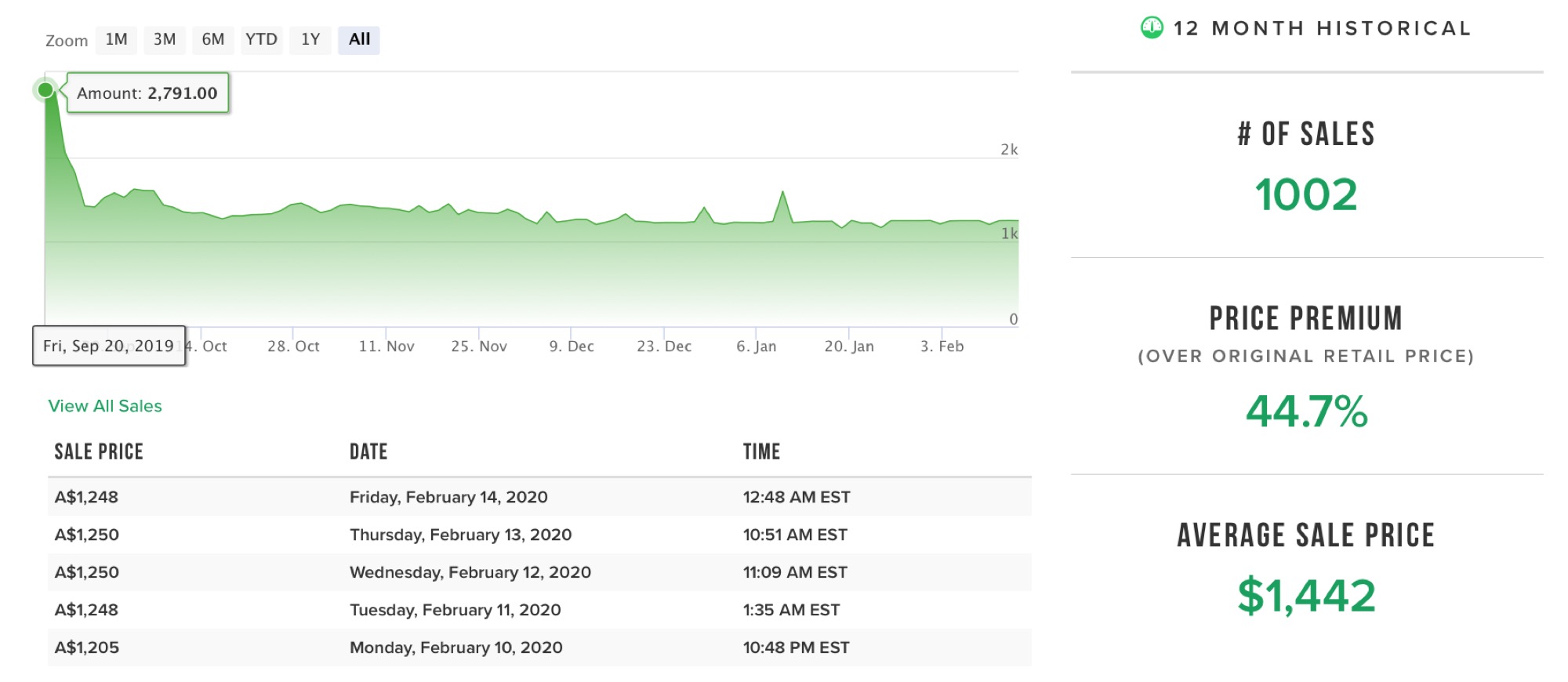
At the NGV, the KAWS Gone figures hit the global market at KAWS Retail and via Donnelly’s kawsone.com on the same day with a retail price of US$580 (AUD$985). It instantly appeared on the secondary resale market (through Detroit-based StockX, Bump, Stadium Goods, Ebay and even Gumtree) and reached a high of US$2,727, before tanking to an average price of US$1,442 (still 44.6% above retail).
KAWS: Companionship in the Age of Loneliness demonstrates that the NGV is not shy; it is boldly and aggressively aiming at a new target market: the largely Asian, middle- and upper-middle- classes who have significant amounts of cash to spend—and are ready, willing and able to spend it. One online investment adviser calls them “bubble drunk millennials” (drunk on historically low interest rates that have seen private debt quintuple over the past 15 years).
In an article in The Age, the exhibition curator Simon Maidment explicitly cites the huge popularity of KAWS throughout Asia: “It’ll be fascinating to see the response too, in particular, from the local south-east Asian student community here.” It’s strong forward thinking by the NGV aimed at diversifying audiences and incomes streams (the NGV’s done well to increase ticketing sales income over the past few years). And it’s a smart strategy; the Chinese middle class is forecast to double from about 300 million to 600 million people in the next five years. KAWS: Companionship in the Age of Loneliness has flung the NGV into this international arena.
In certain respects, KAWS Retail is unlike a traditional museum gift store because it is targeted at a different kind of museum visitor: a genuine consumer-collector who is largely indistinguishable from a traditional art collector. Taking up the artistic tradition of the multiple (represented by figures like Lucio Fontana, Piero Manzoni, Andy Warhol and Takashi Murakami), KAWS Retail offers to the museum-goer artworks that are of equal authenticity as those on display in the NGV exhibition space. The small KAWS Gone sculpture on offer in KAWS Retail is strictly speaking equivalent to other sculptures on display. Aside from scale, there is basically nothing that distinguishes it.
KAWS Retail may also offer a way for the NGV to generate new kinds of income by offering artworks (usually the role art dealers) direct to cashed up middle-class visitors. The populism of KAWS: Companionship in the Age of Loneliness therefore needs to be seen from the perspective of equity. KAWS Retail appears to have generated an unparalleled capacity to raise a strange kind of “visitor-equity” from the consumer-collector, which one-day could be a potential new source of income that reliably funds new NGV commissions and acquisitions. According to one source, KAWS Retail has raised enough “equity” (in dollar terms) to pay for the huge 7-meter bronze KAWS Gone (2019) sculpture the NGV commissioned for the Federation Court. And a large portion of these funds were generated through what was a kind of “initial public offering” of the small KAWS Gone figure, as if the museum visitor in some sense purchases a share in this part of the KAWS universe, a spectral shadow of the larger KAWS Gone sculpture.
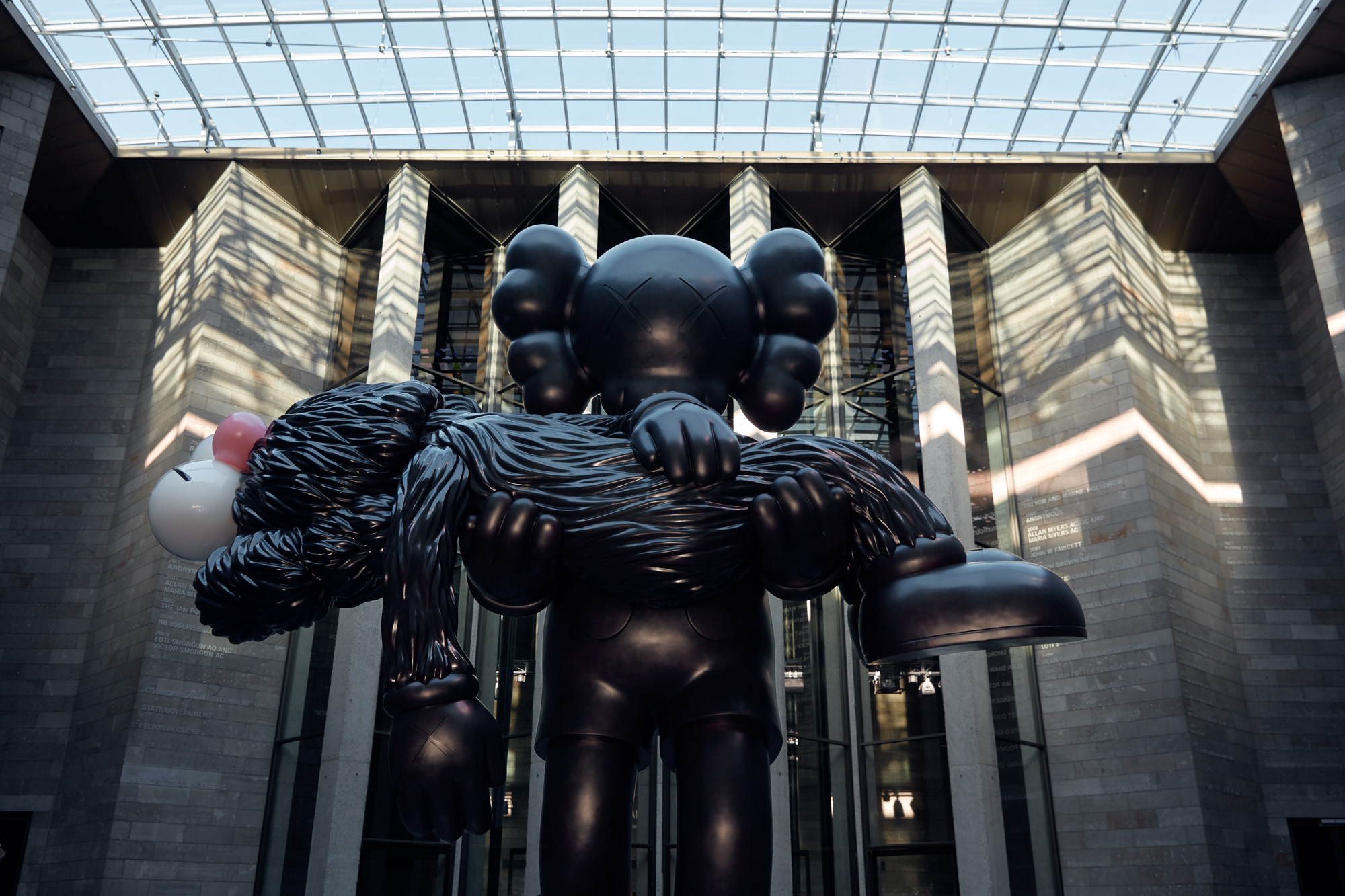
Why, then, is the NGV presenting such an aggressive program to reach new markets and audiences? The NGV makes up 7.6% of the $1.8 billion Art Galleries and Museums industry revenue. Traditionally, the sector derives most of its revenue through public funding and private grants, alongside ticket admissions and merchandise sales. KAWS Retail appears to be an aggressive forward step (it’s too early to tell how successful it has been) by the NGV to diversify their income streams, to move away, relatively speaking, from its traditional reliance on public grants, private donations and corporate sponsorship.
In fact, this aggressive forward step could be explained by recent declines (or at least stagnation, because this recent fall is partly explained by the unprecedented highs caused by the 2017 $17 million AGL Shaw Bequest) in fundraising activities income at the NGV. Over the past year, the NGV’s market share has also fallen noticeably.
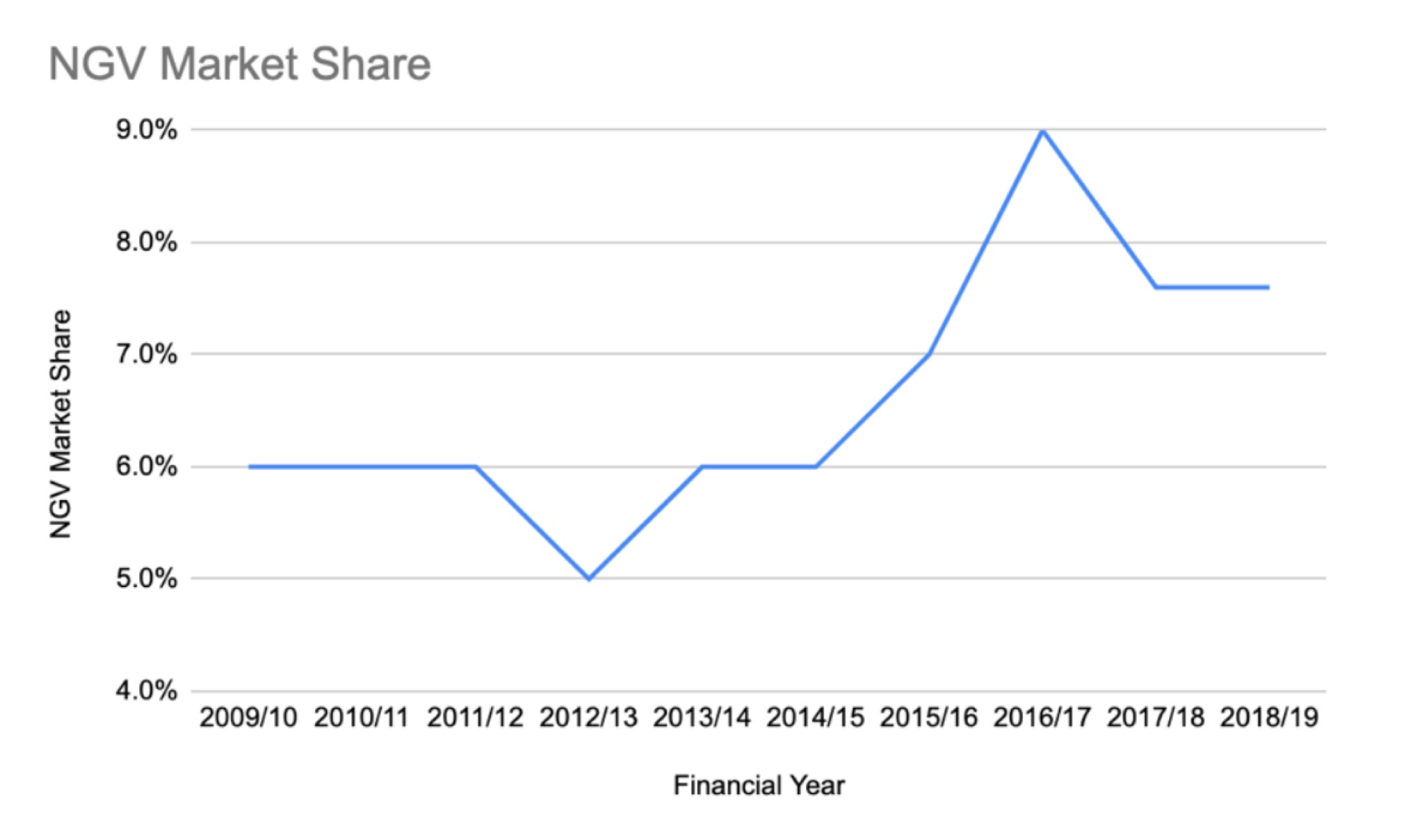
Based on social media analytics I was able to obtain, the NGV’s #ngv has experienced a noticeable decline on Instagram since early 2018 (when it reached a peak during the Triennial) (the #kawsngv is also included as it is the official hashtag of the KAWS exhibition).

The same can be said for the number of likes of posts that include the #ngv tag. Since the start of 2017, the tag would have experienced basically no growth were it not for the incredible success of the #kawsngv tag (the attempted #KAWSChadstone is so far wildly unsuccessful with only 41 posts!) coupled with the social media and marketing power of Brian Donnelly’s @kaws account. In fact, according to these analytics, without the help of @kaws (blue spike), the NGV Instagram analytics remain basically flat (red) for the past three years beyond a brief first quarter spike during the 2018 Triennial. That is to say, from the perspective of Instagram likes, the NGV would appear to have nothing to boast about—were it not for @kaws.

A similar trend can be observed in relation to Instagram likes for #ngv (falling), NGV visitors (falling) and NGV fundraising activities (falling). Total NGV visitors fell in 2018/19, returning close to 2016/17 levels (green). (There are even reports that some internal measures show that staff morale at the NGV reached lows at the end of last year).

With Brian Donnelly’s @kaws account (2.7M followers), the NGV’s reach and market is expanded hugely (illustrated by the divergence between the red and blue lines above, from 3.3M likes without the support of @kaws (red) to 5.5M likes with the support of @kaws (blue)). This growth is not merely a growth in the NGV’s online “virtual” audience numbers, but also a huge expansion of global reach and audience diversification. Further evidence of this can be seen through the web platforms that have been administering and capitalising on these retail “asset” transfers. At the time of writing, the three colourway of the KAWS Gone figure arethe staple piece of StockX’s Collectibles page.
Is this really a new beefed-up model of fundraising, in which the exhibition-visitor truly believes they are purchasing a genuine asset class (i.e., the KAWS Gone sculpture)? It’s obviously too early to tell. Who knows what the figures will amount to—but the results of the NGV’s 2020 Financial Report will be interesting to observe.
How does the exhibition itself reflect on these conditions? “Hype is a big excitement that has a deep emptiness at its core.” This is what the host of the Netflix show The Patriot Act, Hasan Minhaj, recently said of hype culture. This emptiness was cleverly and openly drawn upon by the NGV to bolster the central themes of the exhibition: themes of universal feelings of isolation and loneliness (KAWS Playtime’s central theme was friendship), of vulnerability, fragility and darkness. At the entrance of the NGV we see an emotional KAWS figure brooding at the Waterwall; and the large Michelangelo inspired Pietà features a KAWS GONE figure holding a dead BFF. The NGV present these themes of emptiness as the fabric of our contemporary world. Maidment even reflects on this condition in the final pages of his essay in the exhibition catalogue. Yet this emptiness can also be found in the work itself; for example, in the total absence of narrative within the KAWS universe, where no story ever surfaces. The KAWS characters are all choked, mute. Interestingly, KAWS characters rarely even have mouths.
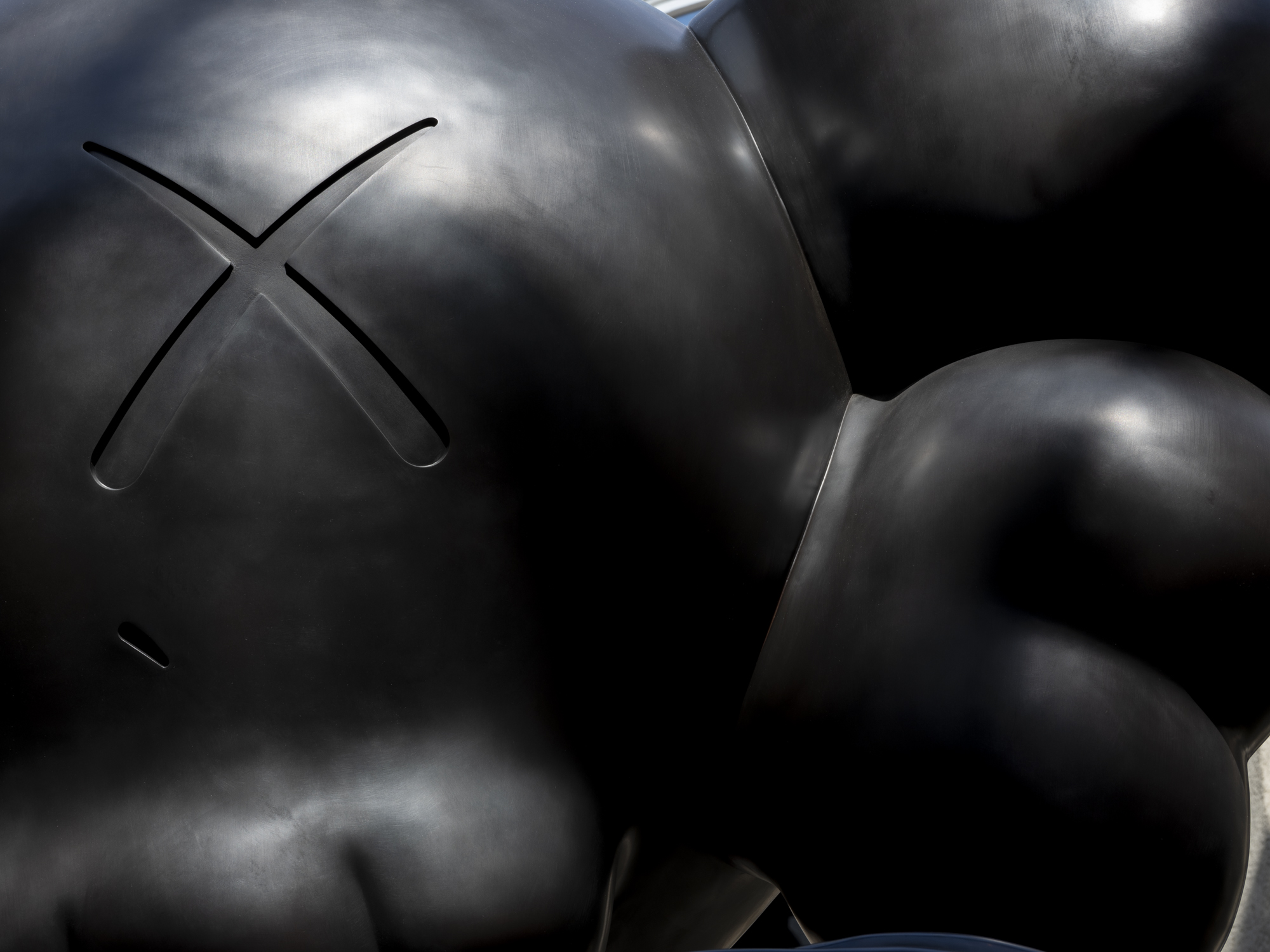
The Italian critic and art historian Celant—one of the few enthusiastic cultural critics to embrace KAWS—argues that at the heart of the KAWS universe is what he calls “pure communication”. His essay is translated from the Italian, and I suspect that by “communication” he meant something more like “exchange”:
In the context of a globalized society, where the different networks contribute to create things devoid of any meaning other than that of pure communication, perhaps all that remains is to speak of the void and the nothingness that is in our eye, those two Xs that by now seem to belong to a blind universe inhabited only be brand names and logos, the two Xs of a world of death.
Celant, however, fails to consider the difference between this “nothingness”—denoted, for him, by KAWS’s iconic Xs—and that which is simply nothing. Nothing, for example, separates one KAWS Gone from another; nothing is said by the characters in the KAWS universe; nothing is exchanged or communicated with the viewer (as Celant himself writes).
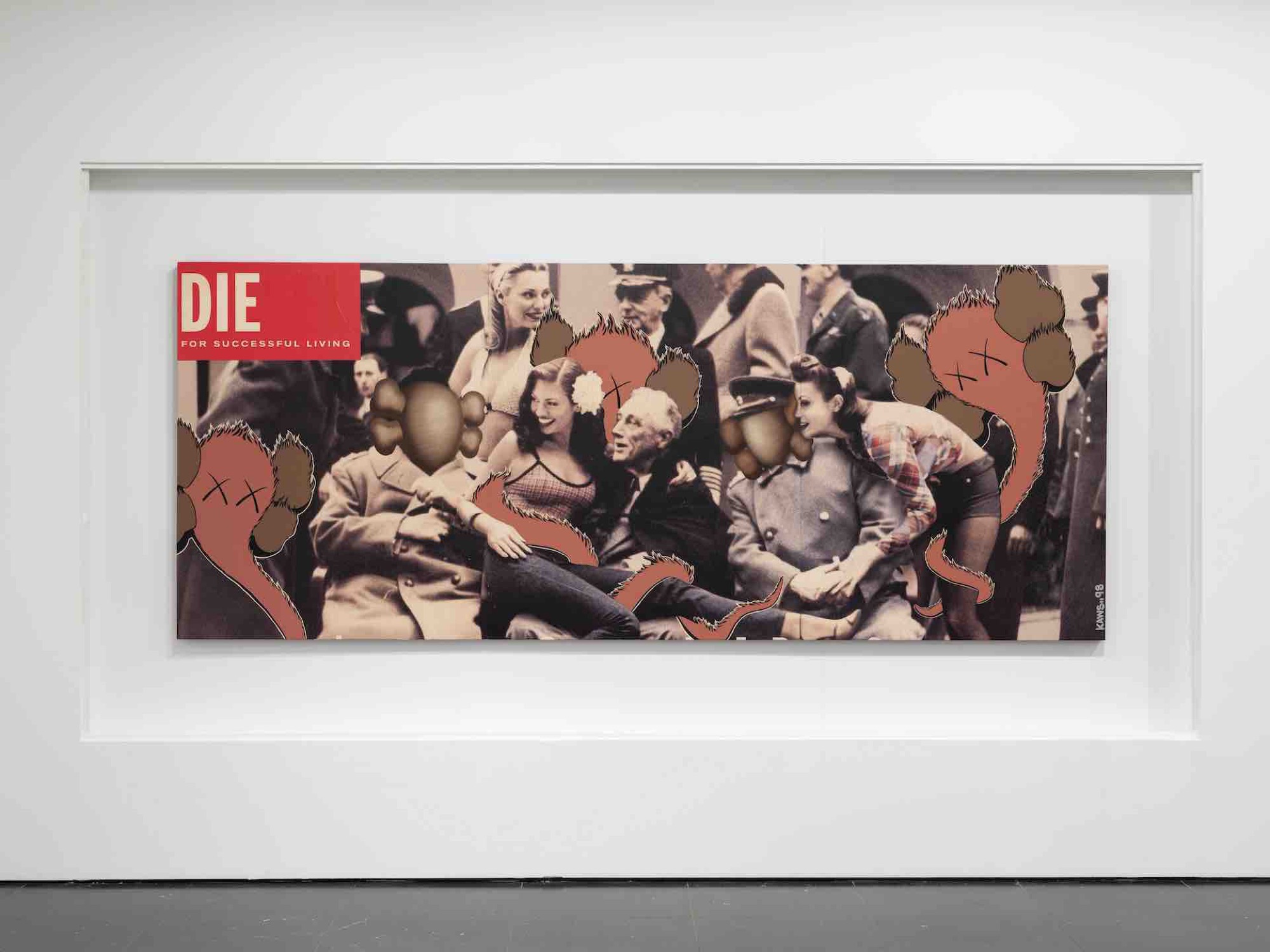
Celant’s idea of nothingness, on the other hand, is really an existential or even ontological category. That’s why philosophers write books with titles like “Being and Nothingness”. Nothingness is the idea of nothing when it is reflected on, contemplated, thought about. But KAWS is not at all existential and ontological in this way. Less than nothingness, perhaps we could say that the KAWS universe really offers an opportunity to contemplate this difference between nothing and nothingness, to access this strange space that is nothing, but not quite nothingness.
Audiences were offered no better opportunity to explore this space in the KAWS universe than at the NGV’s public meditation program Still Together, presented in collaboration with A–SPACE, and held at the foot of the giant KAWS Gone sculpture in the NGV Federation Court. Funnily, the NGVs webpage for the event even cites (without a source) the 19th century nihilist philosopher Friederich Nietzsche (although I’m pretty sure the NGV has misattributed the quote): “’Invisible threads are the strongest ties.’ – Friedrich Nietzsche”.
Some may wonder if seasoned NGV patrons will be put off by the nihilist themes of KAWS: Companionship in the Age of Loneliness. Perhaps these patrons—who traditionally value the lofty ideals of “Art” as well as the cultural cache of patronage—are focussed on other things, like building private museums. In any case, would they really be interested in Uniqlo collaborations? The old guard may need to go elsewhere to find a reflection of its traditional values and sources of cultural distinction and prestige. Will a new generation (and demographic) of consumer-collectors and cultural philanthropists be enticed by the NGV’s new offerings? Maybe they will. Nothing’s stopping them.
Paris Lettau is a writer based in Melbourne.
